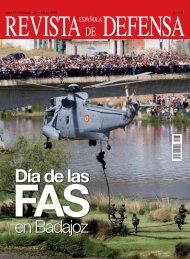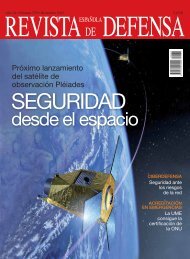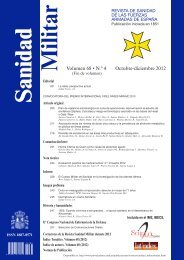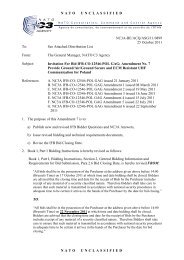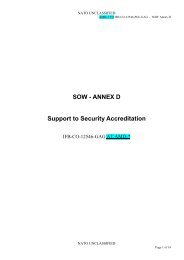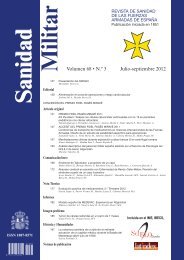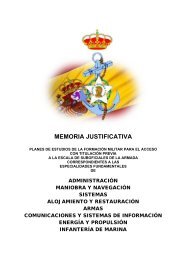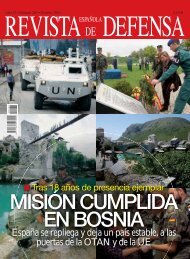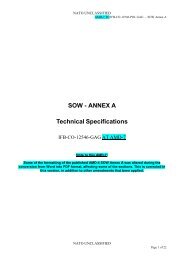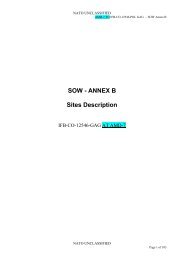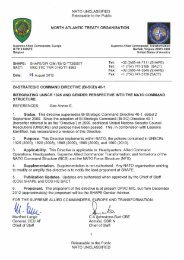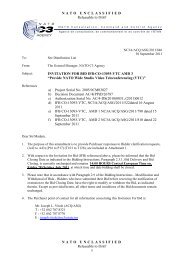Sanidad Militar - Ministerio de Defensa
Sanidad Militar - Ministerio de Defensa
Sanidad Militar - Ministerio de Defensa
Create successful ePaper yourself
Turn your PDF publications into a flip-book with our unique Google optimized e-Paper software.
<strong>Sanidad</strong> <strong>Militar</strong><br />
Revista <strong>de</strong> <strong>Sanidad</strong> <strong>de</strong> las Fuerzas Armadas <strong>de</strong> España<br />
Sanid. Mil. Volumen 68, número 1. ISSN: 1887-8571 Enero-marzo 2012<br />
CONTENTS<br />
EDITORIAL<br />
7 Spanish Medical Advisors in Kampala<br />
Alsina Álvarez J.<br />
ORIGINAL ARTICLE<br />
8 Analgesia in the management of the combat casualty. Experience of the Spanish Medical Service<br />
Navarro Suay R., Castillejo Pérez S.<br />
SUMMARY: Antece<strong>de</strong>nts and Objectives: the analgesia of the woun<strong>de</strong>d has played a vital role in military medicine. Nowadays<br />
it still is a medical, tactical and logistical challenge in the integral management of the combat casualty. The objective of this<br />
study is to evaluate the homogeneity of the analgesic drugs used, starting point of the treatment, number and type of administration<br />
routes, as well as the type of anesthesia used in gunshot or explosive <strong>de</strong>vice casualties in the Spanish Role 2 in Herat<br />
(Afghanistan) between 2005 and 2008, in accordance with an anatomical injury severity score (NISS) of the injuries. Material<br />
and Methods: we carried out an observational, retrospective study with a sample of 256 patients. Results: the drugs most<br />
commonly used were the NSAIDs (73%) followed by major morphine <strong>de</strong>rivatives (44%), adjuvants (29%) minor morphine<br />
<strong>de</strong>rivatives (21%) and ketamine (12%). In 61 % of the cases the analgesia was administered in the prehospital setting and in 31<br />
% in the hospital. The most common administration route was intravenous (79%). In 75% of the cases only one administration<br />
route was obtained for analgesia. General anesthesia was the most common anesthetic procedure (32%). Conclusions: analgesic<br />
treatment of the combat casualties studied was homogeneous in terms of drugs used and number and types of administration<br />
routes. However it was heterogeneous in reference to the chosen type of NSAIDs and initiation of analgesic drug administration.<br />
KEY WORDS: Analgesia, Combat, Pain, Spanish Medical Service, Afghanistan.<br />
17 Beta-hemolytic streptococci in school children<br />
Miranda García MC.<br />
SUMMARY: Introduction: Streptococci are responsible for different infectious diseases in the community; some of them with<br />
serious consequences as rheumatic fever, endocarditis, glomerulonefritis, alopecia or scarlet fever, and have the potential to cause<br />
outbreaks in closed communities like school children. Objectives: the objective of this study was to <strong>de</strong>termine the frequency<br />
and variability of the different groups of beta-hemolytic streptococci in carrier school children (12-18 years old) in different<br />
schools in the town of San Fernando, as well as their antimicrobial susceptibilities. Material and Methods: samples taken from<br />
160 school children of both sexes were cultured and incubated for 48 hours. Gram stains, catalase tests and bacitracin sensitivity<br />
tests were carried out. Serogroups were i<strong>de</strong>ntified by agglutination tests using the Oxoid kit. Antimicrobial susceptibility was<br />
<strong>de</strong>termined with Becton-Dickinson discs with different antibiotics. Results: from 34 positive samples we isolated 6 group A<br />
beta hemolytic streptococci strains (3,75%), 2 group B strains, 5 group C, 10 group F, 6 group G and 5 non-groupables (consi<strong>de</strong>red<br />
important due to the abundance of colonies on the plate). Although not significant we found a higher frequency of groups<br />
A and G streptococci in males and groups C and F in females. Conclusions: the frequency of the isolated groups B, C, F, G and<br />
non-groupable beta hemolytic streptococci represents a higher percentage in comparison with studies carried out in other cities.<br />
As for the strains of S. Pyogenes we found antimicrobial susceptibility and resistance rates similar to those of other cities, but<br />
lower than that of the Valencia study in 2002.<br />
KEY WORDS: beta hemolytic streptococci, carrier school children, susceptibility.<br />
22 Development and validation of a method for simultaneous <strong>de</strong>termination of pseudouridine and creatinine in human<br />
urine. Evaluation’s In<strong>de</strong>x Pseudouridona /Creatinine in smokers and no-smokers<br />
Montenegro Álvarez <strong>de</strong> Tejera P., Chamorro Merino G., Cabanes Mariscal MªA., Sánchez López P., Medina Font J.<br />
SUMMARY: Introduction: The excretion of pseudouridine is increased in inflammatory processes related to loss of muscle<br />
mass found in patients with pulmonary involvement. Material and Methods: A rapid and sensitive method for quantitative and<br />
simultaneous <strong>de</strong>termination of pseudouridine, a breakdown product of tRNA, and creatinine in human urine via HPLC was<br />
<strong>de</strong>veloped and validated. The mobile phase was 0.01 mol phosphate buffer (pH 6.1) containing 3 mmol octanesulphonic acid as<br />
ion pairing agent. Sample preparation is based on dilution and filtration. A LiCHros-pher ® 100 RP-18 (5 µm) LiCHroCART ®<br />
250-4 (Merck) column with precolumn LiCHrospher ® 100 RP-18 (5 µm) LiCHroCART ® 50-4 (Merck) were used, flow rate of<br />
Sanid. mil. 2012; 68 (1) 3



